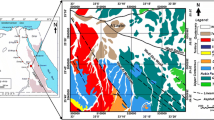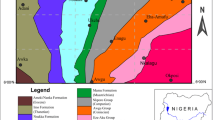Abstract
An interpretation of aeromagnetic data was conducted in the Pitoa–Figuil area (Northern Cameroon). The aim of this investigation was the first to emphasise lineaments hidden under geological formations and secondly to propose two 2.75D models of the subsurface structures. Different magnetic data processing techniques were used, notably horizontal gradient magnitude, analytic signal and Euler deconvolution. The application of these techniques made it possible to map a certain number of lineaments representing discontinuities of magnetic susceptibility, mainly oriented NE–SW, NW–SE, E–W and ENE–WSW. The predominant direction for major lineaments is NE–SW and NW–SE. The major NE–SW trends have been attributed to the consequences of the Benue trough set-up due to the Atlantic opening. The lineaments map associated with the Euler solutions permits us to highlight and characterise 18 faults and some intrusive bodies. Euler solutions indicate depths down to 5.3 km for anomaly sources. The 2.75D modelling from the aeromagnetic anomaly reduced to the equator permits to understand the stratification of the deep and near-surface structures, which are sources of the observed anomalies. The sediment thickness values (3.5–4 km) combined with the presence of numerous deep faults make this area a potential site for hydrocarbon accumulations.









Similar content being viewed by others

Data availability
The corresponding author guarantees the availability of the data used to carry out this study.
References
Achilleos GA (2010) Approaching a model for estimating horizontal errors of digitized contours. J Spat Sci 55:147–164. https://doi.org/10.1080/14498596.2010.487856
Akande SO, Egenhoff SO, Obaje NG, Ojo OJ, Adekeye OA, Erdtmann BD (2012) Hydrocarbon potential of cretaceous sediments in the lower and middle benue trough, nigeria: insights from new source rock facies evaluation. J Afr Earth Sci 64:34–47
Blakely RJ, Simpson RW (1986) Approximating edges of source bodies from magnetic or gravity anomalies. Geophysics 51:1494–1498
Clark DA, Emerson DW (1991) Notes on rock magnetization characteristics in applied geophysical studies. Explor Geophys 22:547–555
Daouda D, Tchameni R, Bascou J, Wangmene SA, Tchunte PM, Bouchez JL (2017) Microstructures and magnetic fabrics of the ngaoundéré granite pluton (Cameroon): Implications to the late-pan-african evolution of central cameroon shear zone. J Afr Earth Sci 129:887–897
Durrheim RJ, Cooper RJ (1998) EULDEP: a program for the euler deconvolution of magnetic and gravity data. Comput Geosci 6:545–550
Grauch VJ, Cordell L (1987) Limitations of determining density or magnetic boundaries from the horizontal gradient of gravity or pseudogravity. Geophysics 52:118–121
Houketchang BM, Penaye J, Njel UO, Moussango AP, Sep JP, Nyama BA, Wassouo WJ, Abate JM, Yaya F, Mahamat A, Hao Y, Fei Y (2016) Geochronological, geochemical and mineralogical constraints of emplacement depth of TTG suite from the sinassi batholith in the Central African fold belt (CAFB) of northern Cameroon: implications for tectonomagmatic evolution. J Afr Earth Sc 116:9–41
Jeng Y, Lee YL, Chen CY, Lin JM (2003) Integrated signal enhancements in magnetic investigation in archaeology. J Appl Geophys 53:31–48
Kallivokas LF, Fathi A, Kucukcoban S, Stokoe KH II, Bielak J, Ghattas O (2013) Site characterization using full waveform inversion. Soil Dyn Earthq Eng 47:62–82
Kamguia J, Manguelle-Dicoum E, Tabod CT, Tadjou JM (2005) Geological models deduced from gravity data in the Garoua basin, Cameroon. J Geophys Eng 2:147–152
Keating P, Pilkington M (2004) Euler deconvolution of the analytic signal and its application to magnetic interpretation. Geophys Prospect 52(3):165–182
Khattach D, Mraoui H, Sbibih D, Chennouf T (2006) Analyse multi-échelle par ondelettes des contacts géologiques: application à la vimétrique du maroc nord oriental. Geoscience 338:521–526
Kravchinsky VA, Hnatyshin D, Lysak B, Alemie W (2019) Computation of magnetic anomalies caused by two-dimensional bodies of arbitrary shape: derivation and Matlab implementation. Geophys Res Lett 46:7345–7351
Malehmir A, Urosevic M, Bellefleur G, Juhlin C, Milkereit B (2012) Seismic methods in mineral exploration and mine planning - Introduction. Geophysics 77(5):WC1–WC2. https://doi.org/10.1190/2012-0724-SPSEIN.1
Marson I, Klingele EE (1993) Advantages of using the vertical gradient of gravity for 3D interpretation. Geophysics 58:1588–1595
Ngako V, Affaton P, Nnange JM, Njanko T (2003) Pan-African tectonic evolution in central and Southern Cameroon: transpression and transtension during sinistral shear movements. J Afr Earth Sci 36:207–214. https://doi.org/10.1016/S0899-5362(03)00023-X
Ngako V, Affaton P, Njonfang E (2008) Pan-african tectonics in Northwestern Cameroon, implication for the history of Western Gondwana. Gondwana Res 14:509–522
Ngoh J, Mbarga T, Mickus K, Tarek Y, Tabod T (2020) Estimation of curie point depth (CPD) across the pan african belt in Northern Cameroon from aeromagnetic data. Open J Earthq Res 9:217–239
Nguimbous KJ, Ndougsa MT, Njandjock NP, Eyike A, Campos-Enriquez JO, Manguelle-Dicoum E (2010) The structure of the goulfey-tourba sedimentary basin (Chad-Cameroon): a gravity study. Geofis Int 49:412–425
Njandjock NP, Manguelle-Dicoum E, Ndougsa T, Tabod TC (2006) Spectral analysis and gravity modelling in the Yagoua, Cameroun, sedimentary basin. Geofis Int 45:209–215
Njanko T, Nédélec A, Kwékam M, Siqueira R, Esteban L (2010) Emplacement and deformation of the fomopéa pluton: implication for the pan-african history of Western Cameroon. J Struct Geol 32:306–320
Ntsama AJ, Bessong M, Hellc JV, Mbesse CO, Nolla JD, Dissombo EA, Takem EJ, Mbassa BJ, Mouloud B, Vignaud PJ, Mfoumbeng MP (2014) The importance of diagenetic processes in sandstones facies of the hamakoussou sedimentary basin in North Cameroon: influence on reservoir quality. Int J Sci Basic Appl Res 13:220–230
Paterson G, Ltd W (1976) Études aéromagnétiques sur certaines régions de la republique unie du Cameroun. Rapport d’interprétation Agence Canadienne de Développement International, Toronto, Canada
Rasmussen R, Pedersen LB (1979) End corrections in potential field modelling. Geophys Prospect 27:749–760
Roest WR, Verhoef J, Pilkington M (1992) Magnetic interpretation using the 3D analytic signal. Geophysics 57:116–125
Sengbush RL (1986) Geophysical exploration for hydrocarbons. Petroleum exploration: a quantitative introduction. Springer, Dordrecht, p 55
Silva JB (1986) Reduction to the pole as an inverse problem and its application to low-latitude anomalies. Geophysics 51:369–382
Skalbeck JD, Karlin RE, Shevenell L, Widmer MC (2005) Gravity and aeromagnetic modelling of alluvial basins in the southern truckee meadows adjacent to the steamboat hills geothermal area, Washoe County, Nevada. Geophysics 70:81–89
Smyth HR, Morton A, Richardson N, Scott AR (2014) Sediment provenance studies in hydrocarbon exploration and production: an introduction. Geol Soc Lond Spec Publ 386:1–6
Sudhir J (1988) Total magnetic field reduction-the pole or equator? A model study. Can J Explor Geophys 24:185–192
Tedla GE, Van der Meijde M, Nyblade AA, Van der Meer FD (2011) A crustal thickness map of Africa derived from a global gravity field model using euler deconvolution. Geophys J Int 187:1–9
Toteu SF, Penaye J, Poudjom YD (2004) Geodynamic Evolution of the pan-african belt in Central Africa with special reference to Cameroon. Can J Earth Sci 41:73–85
Whitehead N, Musselman C (2005) Processing, analysis and visualization system for 3D inversion of potential field data in oasis montaj v6.1. Montaj Grav/Mag Interpretation. https://fr.scribd.com/document/349623750/montajGravMagInterpretation-pdf/
Acknowledgements
The University of Yaoundé I in Cameroon is the institution in which this work was done, counting for the first author’s PhD thesis work. The authors are grateful to the reviewers for their valuable observations and constructive criticism making the manuscript clear.
Funding
No funding was received for conducting this study.
Author information
Authors and Affiliations
Contributions
Georges Voltaire Souga Kassia contributed to data processing, interpretation and writing. Théophile Ndougsa Mbarga contributed to supervisor, methodology, materials and data supplier. Arsène Meying contributed to geological analysis. Jean Daniel Ngoh contributed to geodata analysis and interpretation. Steve Ngoa Embeng contributed to geophysical data management software.
Corresponding author
Ethics declarations
Conflict of interest
The authors certify that they have no competing interests to declare that are relevant to the content of this article.
Ethics approval
This article does not contain any studies involving human participants or animals performed by any of the authors.
Additional information
Edited by Prof. Teresa Grabowska (ASSOCIATE EDITOR) / Prof. Ramón Zúñiga (CO-EDITOR-IN-CHIEF).
Rights and permissions
Springer Nature or its licensor (e.g. a society or other partner) holds exclusive rights to this article under a publishing agreement with the author(s) or other rightsholder(s); author self-archiving of the accepted manuscript version of this article is solely governed by the terms of such publishing agreement and applicable law.
About this article
Cite this article
Kassia, G.V.S., Mbarga, T.N., Meying, A. et al. Structural features derived from a multi-method approach and 2.75D modelling of aeromagnetic data: a case study of the Pitoa–Figuil area (Northern Cameroon). Acta Geophys. 71, 587–600 (2023). https://doi.org/10.1007/s11600-022-00987-1
Received:
Accepted:
Published:
Issue Date:
DOI: https://doi.org/10.1007/s11600-022-00987-1



